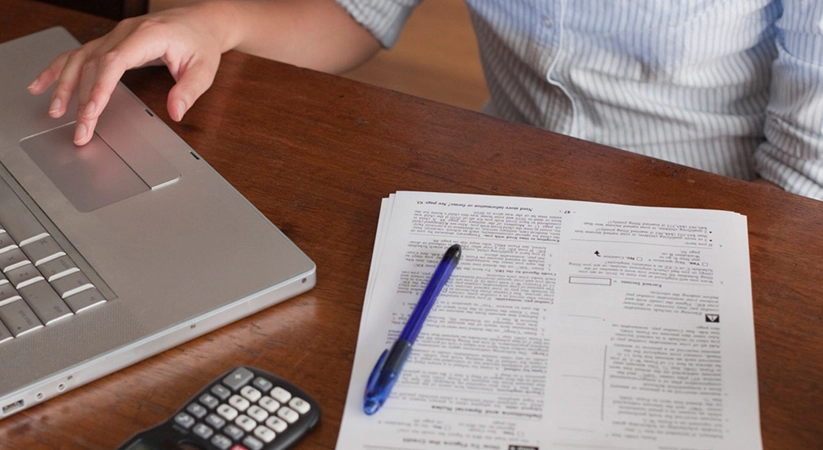Can I claim a home office tax deduction?
Published:
If you use part of your home for business, you may be able to benefit from the home office tax deduction. This tax help can be used by individuals who are employees or who are self-employed. Claiming the home office tax deduction is a good tax strategy to employ if you are eligible because it allows you to deduct certain expenses that the average homeowner cannot. Deducting the costs associated with your home office helps lower your taxable income, and thus your overall tax bill. The home office tax deduction is an itemized deduction.
NOTE: Tax deductions lower your taxable income and they are equal to the percentage of your marginal tax bracket. For instance, if you are in the 25% tax bracket, a $1,000 deduction saves you $250 in tax (0.25 x $1,000 = $250). There are two main types of tax deductions: the standard deduction and itemized deductions. A taxpayer must use one or the other, but not both. It is generally recommended that you itemize deductions if their total is greater than the standard deduction.
According to the IRS, you must meet three main requirements in order to be eligible for the home office tax deduction. You must use a portion of your home exclusively and regularly:
- as your principal place of business, or
- as a place to meet or deal with clients/customers in the normal course of your business, or
- in any connection with your trade or business where the business portion of your home is a separate structure not attached to your home
Exclusive & Regular Use
In order to qualify for the home office tax deduction, the IRS requires that you regularly use a portion of your home exclusively for conducting business. In other words, you cannot put a computer in the guest room and call it a home office. You also cannot allow your children or spouse to use your office for their own projects. To be eligible, your home office must be a separate room or identifiable area from which personal activities are excluded. The IRS is very adamant about the exclusive-use requirement, although there is less clarity when it comes to the definition of “regular use.” Conducting business from your home office at least a couple hours every day is likely enough to satisfy the regular-use requirement.
Principal Place of Business and/or a Place to Meet with Clients
To be eligible for the home office tax deduction, you must demonstrate that you use your home office as your principal place of business. This means that the office portion of your home must be used significantly and consistently for business activities, or as a place where you meet with your clients/customers in the normal course of your business. Keep in mind, even if you also conduct business at another location, you can still deduct the expenses associated with the portion of your home that’s used exclusively and regularly for business.
In other words, your home office must be your principal place of business, but not necessarily your principal office. A separate or detached structure (such as a garage or barn) may qualify as a home office if it is used exclusively and regularly for business.
Expenses that Can Be Deducted
The home office tax deduction is a great tax strategy if you know how to use it. The IRS only approves of certain qualified expenses for this tax break. To determine whether an expense can be deducted, there are 3 general rules:
- Only to Home Office — If an expense is related only to your home office, the entire cost is deductible as a “direct” home office expense.
- Entire House — If an expense pertains to the entire house, a portion of it will be deductible as an “indirect” home office expense.
- Non-Business Portion — If an expense is associated only with the non-business part of your home, it is not deductible as a home office expense.
Direct Expenses
Direct expenses are fully deductible under the home office tax deduction. These may include the cost to repair, upgrade, or maintain your home office space.
Indirect Expenses
These types of expenses may help you save the most money because they are associated with your whole house. Indirect expenses can include a portion of your heating, air conditioning, electricity, security system, homeowners insurance, property taxes, and even your monthly mortgage payments. For example, if your home office makes up 20% of your house, you can deduct 20% of your utilities bills under the home office tax deduction.
If you also work at another location, be cautious when claiming certain expenses under the home office tax deduction. Administrative duties (such as bookkeeping, recordkeeping, billing operations, making appointments, and ordering supplies) may qualify as deductible expenses, but your home office must be the only place where you can accomplish these tasks.
Limits on the Home Office Tax Deduction
As with every tax break, there are limits to how much you can deduct for your home office. Note that the amount of your home office tax deduction cannot be more than your home-based business income. In general though, the more substantial your home business activities are, the greater your chances are for qualifying for the home office tax deduction.
For More Information
For more information regarding the home office tax deduction and business use of your home, please refer to the following documents:
- IRS Publication 587 (Business Use of Your Home)
- IRS Tax Form 8829 (Expenses for Business Use of Your Home)
- IRS Tax Form 8829 Instructions
- IRS Tax Form 1040, Schedule C (Profit or Loss from Business)
- IRS Tax Form 1040, Schedule A (Itemized Deductions)



